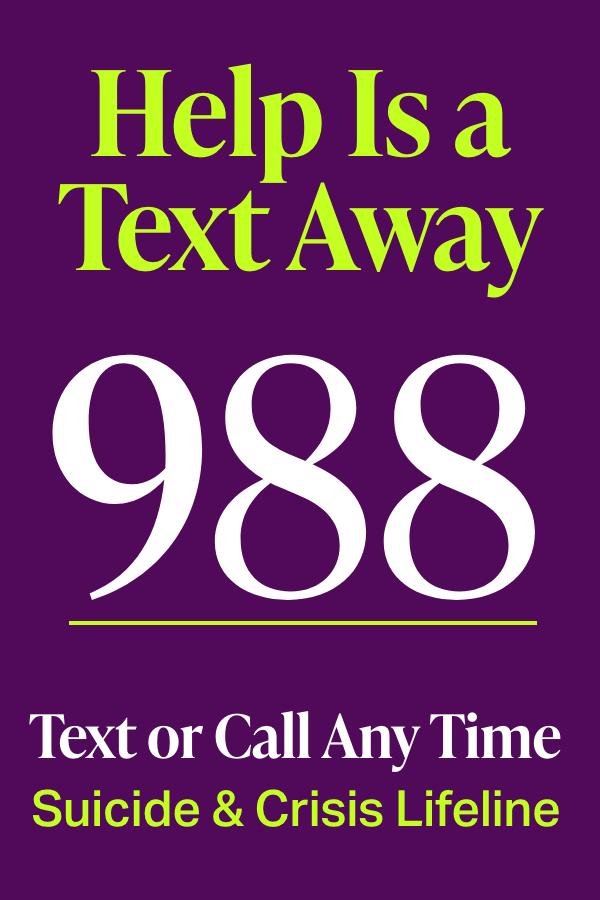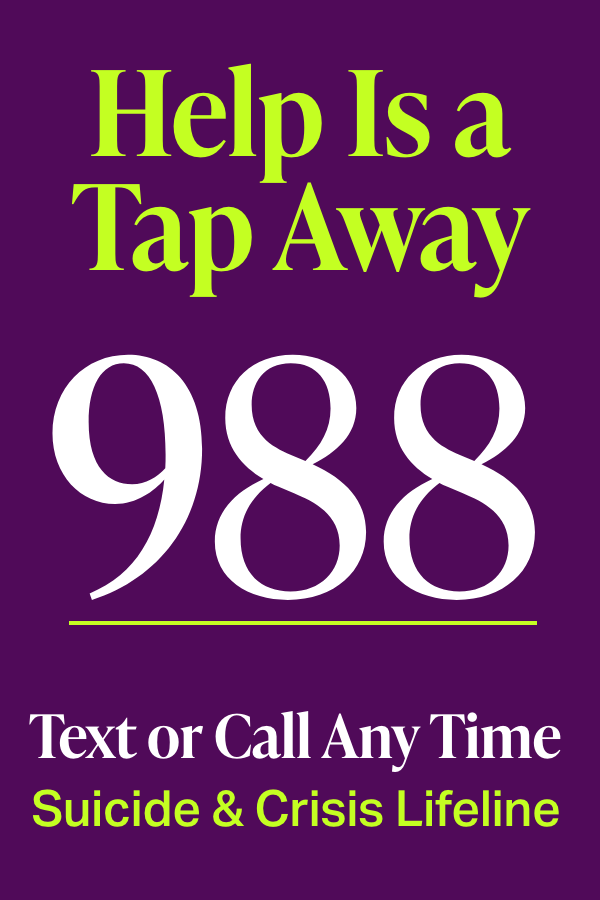You know what they say about idle hands…
Wanna know what we say about idle hands? Religion ain’t involved. But mental health might be.
“We know that sensory input and movement, big or small, can help with handling feelings,” says psychologist Michelle Frank, Psy.D., author of A Radical Guide for Women with ADHD. “For folks with ADHD, in particular, it helps them be more present and brings the world into focus a bit.”
Generally, fidgeting has proven perks. According to a study published in Frontiers in Psychology, fidgeting behavior improved attention to and retention of lecture material. Likewise, participants in another study who were allowed to doodle (considered a type of fidgeting) remembered 29 percent more information than non-doodlers after a surprise memory test.
It might seem counterintuitive that busy hands would still the mind and sharpen thinking. But research has shown that a little side gig for your fingers allows your brain to engage better in a primary activity—even one that’s a super-snooze. Using MRIs, one 2021 study discovered that fidgeting increases blood flow to the prefrontal cortex, a brain zone linked with concentration and decision-making. “Our research,” said one of the study authors, “aims to explore if fidgeting might act as a mild drug-free ADHD stimulant.”
But it’s not just the ADHD gang who might benefit. In those with anxiety, autism, dermatillomania (skin-picking disorder), OCD, and trichotillomania (hair-pulling disorder), your fingers may also do the walking, the talking, the tapping, and the drumming. And sometimes they, too, need something to walk, talk, tap, and drum with.
Take anxiety: Some people experience what’s called psychomotor agitation—energy that needs an outlet. Maybe a Rubik’s Cube is your vessel. Or maybe it’s a softer sumthin’ sumthin’, maybe a furry or velvety fabric, that you can stroke like a cat.
With dermatillomania and trichotillomania and cousin OCD, having something else to pick or pull at can serve as a safer stand-in than your skin, nails, or hair.
Convinced? Let’s idle our way calmer and more focused. As they say, serenity now.
All products featured on Mental have been selected independently and editorially. When you buy from our links, we may earn a commission.
Fidget Ring
Soothe Rings Evil Eye Anxiety Ring, $25
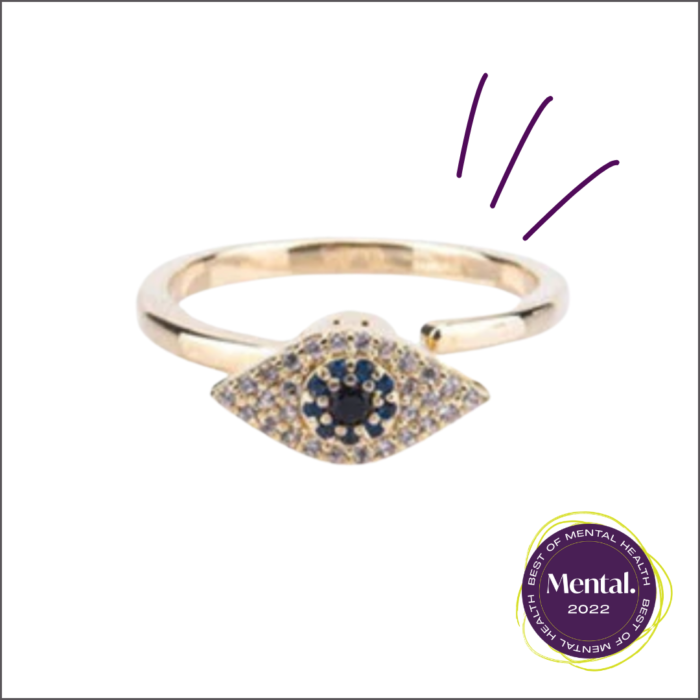
“I would wear this even if it didn’t do anything,” jokes one Mental contributor. Yes, this ring is cool—and an unassuming, grown-up version of a fidget spinner. “A spinning ring might be the right coping tool for someone with ADHD,” says Dr. Frank. Because you can “fiddle covertly,” she explains, it benefits the wearer while not distracting others.
A ring like this also benefits you. The sensory-motor input of a fidget item is meant to stimulate but not pull your entire focus, according to ADD/ADHD experts Roland Rotz, Ph.D., a psychologist, and Sarah D. Wright, an ADD/ADHD life coach. (They’re authors of Fidget To Focus: Outwit Your Boredom: Sensory Strategies For Living With ADD.) It’s why some therapists find classic fidget spinners too distracting: They end up sucking up the attention, vs the actual task at hand.
Our contributor really likes this ring for anxiety-diffusion. And while there isn’t specific data on fidget jewelry and anxiety, there could be something soothing about rhythmic, repetitive activities, says Lori Davis, Psy.D., clinical instructor of psychology in psychiatry at Weill Cornell Medical College, who specializes in anxiety disorders and PTSD. “If it makes you feel good—great.”
Therapy Putty
Crazy Aaron’s Thinking Putty in Super Scarab, $15
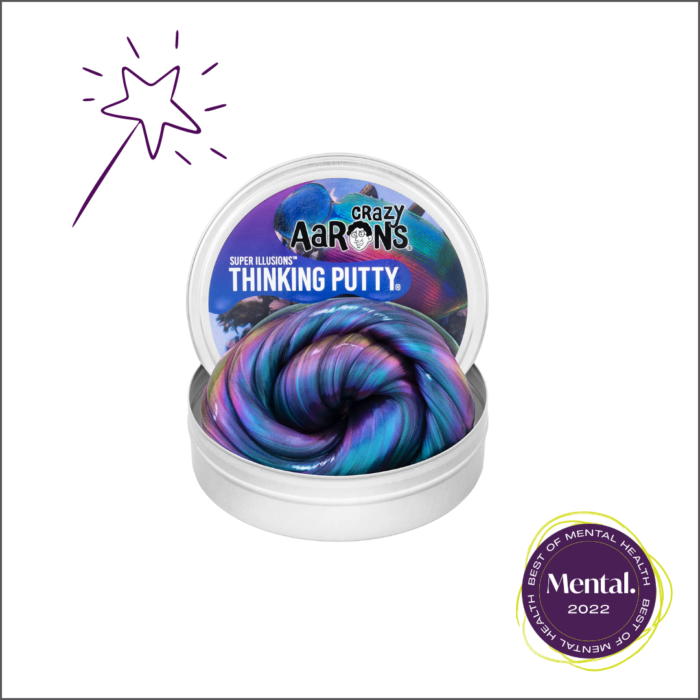 Okay, so the name “Crazy Aaron’s” might conjure “discount furniture store,” but the Metropolitan Museum of Art’s gift shop sells this non-toxic silicone goo, so it’s got Fifth Avenue-level street cred. We like that this fidget toy is quiet—we can use it while on the phone or in Zoom meetings.
Okay, so the name “Crazy Aaron’s” might conjure “discount furniture store,” but the Metropolitan Museum of Art’s gift shop sells this non-toxic silicone goo, so it’s got Fifth Avenue-level street cred. We like that this fidget toy is quiet—we can use it while on the phone or in Zoom meetings.
Experts, like Dr. Frank, endorse playing with putty, too. “People with ADHD often have some sensory sensitivities, and sensory-oriented tools can be soothing and grounding from an emotional-regulation standpoint,” she says. “Also, with ADHD, there’s sort of a constant strum of movement and thinking that happens underneath the surface. Having somewhere to put that energy helps some people with ADHD clear the noise and focus better. A thinking putty can redirect the underlying hum of thought and activity and help someone be a little more present.”
Therapy putty has long been a go-to for sensory issues that can accompany autism. Adapt and Learn, a therapy center in Connecticut, praises Crazy Aaron’s for its lack of scent (for smell-sensitive people) and fun color choices (as opposed to the limited “medical-model” choices one typically finds in therapy catalogs). “Therapists know the benefits of tactile tools for fidgeting to calm anxiety and improve focus,” wrote one of center’s OTs, who works with children who have autism, ADHD, and other sensory processing issues. “Push, pull, twist, rip, cut, stretch, poke! Whatever you can think to do with putty, you can do it with Thinking Putty…just in a more colorful, sparkly way!”
Got nervous energy but no diagnosis? No reason not to try the stuff. “Therapy putty is a great sensory tool for any person who has a need to fidget in order to help them focus or stay regulated,” says Emily Tritz, O.T., an occupational therapist at Kansas City Developmental Therapies in Olathe, Kansas. “The putty is meeting a sensory need that they have—e.g., the need to fidget with their hands in order to pay attention or stay calm.”
Fidget Stone
The Original Pick ‘N Peel Stone Kit, $30.60
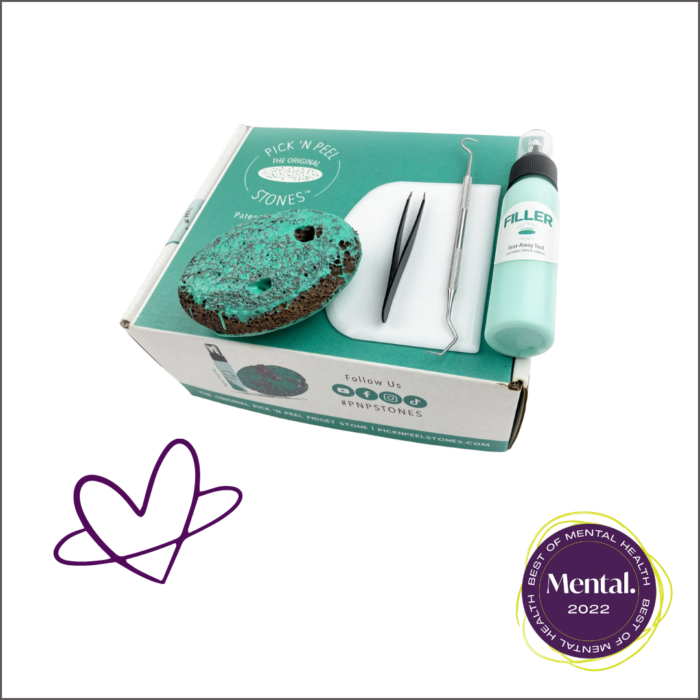
One good thing to come out of the pandemic: this breakthrough idea, whose founder invented it after becoming unemployed in 2020. When you get the urge to pick—your skin, hair, zits—or just feel anxious and need an outlet, you reach for this lava rock instead of your body. As the company puts it, “You can choose whether you would like your fidget stone to mimic skin pulling, scab picking, or even peeling that layer of glue from the back of your new debit card.”
The rock has two sides—one’s covered with tiny little holes filled with a latex-based glue, which you remove with the included picking hook. The other side is completely coated in the glue, ready for you to strip it off. Once done, you clean off the stone, re-glue, and repeat.
“Anytime I feel I’d like to start picking, I remind myself I have this and I stop,” says one reviewer on Etsy. It’s a legit strategy. “Anything that forces you to make a conscious decision to pick or pull is going to act as a barrier to the behavior,” says therapist Lauren Rosen, LMFT, director of The Center for the Obsessive Mind in California, an outpatient treatment center specializing in OCD, anxiety disorders, and eating disorders. If that’s a lava stone filled with glue, amaze.
Per its loving fans on Etsy, the kit helps with…
- Dermatillomania. “I’ve had trouble with skin picking my whole life. The minute I tried this for the first time, I couldn’t put it down. This is the longest I have ever gone without picking at my nails, face, etc. EVER” and “I am an extreme face picker and this stimulates that urge so well!”
- Trichotillomania. “It’s been really soothing to use while I watch TV or am feeling extra stressed. I’ve been more focused on picking the stone rather than my scalp.”
- Acne-picking. “It’s helped me so much instead of bothering my skin/acne. Please get this item; it will save your skin from scars and pain!”
- Anxiety. “It immediately puts my mind in a calm, happy place!” and, as one therapist wrote, “It really does help with anxiety and de-stressing.”
Sensory Fabric Tool
Calmios The Jeffrey, $20
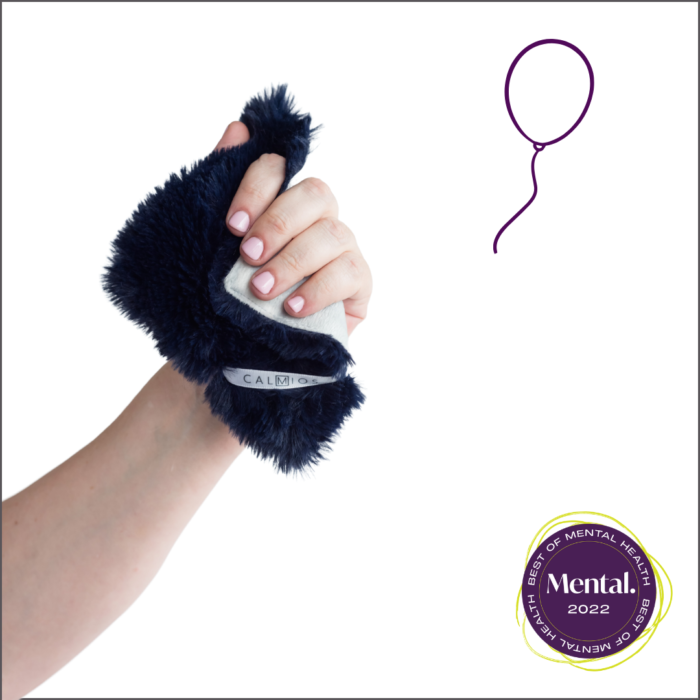
Meet our new boyfriend: His name’s Jeffrey. (Not Jeff. Jeffrey). He’s cute (like a mini fluffy rug), kind (his faux fur is S-O-F-T soft), hardly one-note (he’s micro-fleece on the other side), and makes life easy for us (see: finger-hole loop). He’s also fashionable (that deep navy; the Moroccan pattern on the back), a great travel companion (he lives in a chic travel pouch), and loves to shower together (he’s hand-washable!). We love caressing our cheeks with his blue fuzz when we’re stressed, then running our fingers along the fleece to help us concentrate.
Is it just us? Apparently not. “I have a furry pink handbag and people stop me on the street in New York and just automatically touch my purse. They can connect. The tactile piece is very soothing and comforting,” says Dr. Davis. “When I travel, I bring my fuzzy polar fleece socks because they make me feel less anxious.”
To wit, a review of oxytocin studies published in Frontiers in Psychology showed that light-pressure and massage-like stroking releases oxytocin (one of the “happy” hormones), with the study authors concluding that tactile interventions can help “increase wellbeing” and “reduce anxiety and stress levels.” Another study, in Psychological Research, found that rubbing a soft material along your forearm slowly, with light force, was considered “particularly pleasant.” Jeffrey, for one, is exactly that.
Want more of the most-vetted products and tips for mental health? Sign up for our newsletter and get Mental in your inbox!
Check Out Our Other Best of Mental Health 2022 Categories
I Just Cried (or: I Couldn’t Sleep)
Don’t Tell Me to Calm Down (But I Probably Should)
Geek Out on Our Sources
INTRO
Fidgeting and Retention of Lecture Material: https://www.frontiersin.org/articles/10.3389/fpsyg.2013.00619/full
Doodling and Memory: https://onlinelibrary.wiley.com/doi/abs/10.1002/acp.1561
Fidgeting and Increased Brain Blood Flow: https://www.auckland.ac.nz/en/news/2021/03/22/bioengineers-shows-that-fidgeting-might-help-concentration.html
Psychomotor Agitation: https://www.psycom.net/fidgets-anxiety-adhd-ocd
OCD and Repetitive Actions: https://www.medicalnewstoday.com/articles/fidget-toys-for-anxiety#how-might-they-help
THERAPY PUTTY
Adapt and Learn Review of Crazy Aaron’s: https://www.adaptandlearn.com/post/crazy-aaron-s-thinking-putty-for-fine-motor-and-sensory-fun
FIDGET RINGS
Distracting Fidget Spinners: https://www.psycom.net/fidgets-anxiety-adhd-ocd
Fidgeting and Focus Research (1): https://www.additudemag.com/focus-factors/
Fidgeting and Focus Research (2): https://www.fastcompany.com/3044026/the-science-of-why-we-fidget-while-we-work
Fidgeting and Anxiety: https://www.today.com/health/behavior/anxiety-fidget-rings-stress-rcna36318
SENSORY FABRIC TOOL
Oxytocin and Tactile Stimulation: https://www.ncbi.nlm.nih.gov/pmc/articles/PMC4290532/
Soft Brush Stroking and Pleasant Sensations: https://pubmed.ncbi.nlm.nih.gov/31630220/




